This blog is a follow up to one I wrote a while ago on Paintbrushes, and accompanies the series I’ve done on art equipment. There’s an accompanying Youtube film showing me trialling these four synthetic brushes.
In my last blog (and accompanying Youtube film review of brushes ), I ended up recommending Rosemary and Co. Spotter Red Dot. But since then I’ve painted almost exclusively with my beloved pure sable Winsor and Newton series 7 sable paintbrushes .
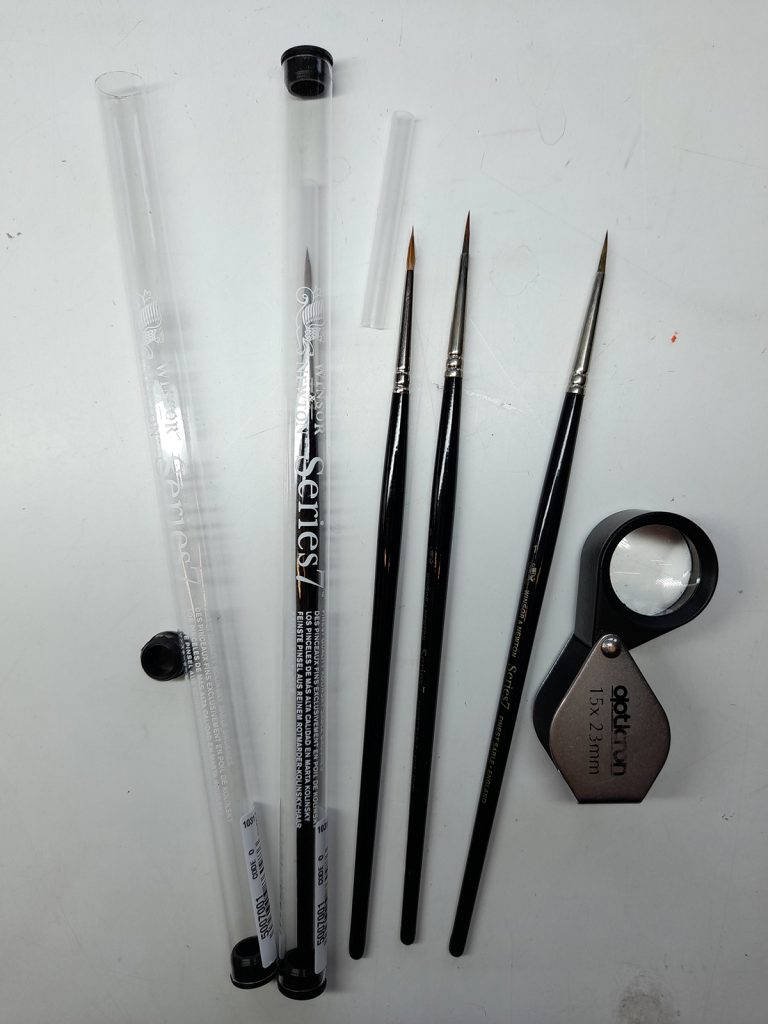
Winsor & Newton Series 7 brushes with hand lens
Sable
Sable brushes are not, in fact, made form the hair of the Sable. These creatures live in Larch woods, and are a type of marten, latin name Martes zibellina. No. The sable used to make watercolour brushes comes from the Kolonok, or Siberian weasel Mustela sibirica.
As a life-long vegetarian, I survived for many years without even thinking properly about the link between animal welfare and my paintbrushes. But following from a chance remark on one of my Youtube videos, I decided to look for synthetics instead. These weasels are voracious predators of rats and other vermin, but can also be pests to poultry farmers. Their fur has long been used to make brushes for artists and calligraphers. But I think I should try to move away from Kolinsky sable brushes if I can.
What other synthetic options are out there? Recommendations and suggestions have come in thick and fast since then, and I’ve managed to get my hands on some of these brushes, and tested them.
The set-up
I need to illustrate the Common Knapweed, Centaurea nigra subspecies nigra. As before, I’ll use a different test brush on different leaves. And hope for the best!
I’m working on Fluid 100 hot press watercolour paper.
In all cases, I test a size 1 brush. This is my default brush size and is perfect for my botanical illustration and natural history work. I’ve ordered all these brushes (except the Rosemary red Dots) through Jackson’s art, a UK based art materials shop. It should also be pointed out that I haven’t been asked or paid to review any of these brushes, so (hopefully) that makes my reviews un-biased.
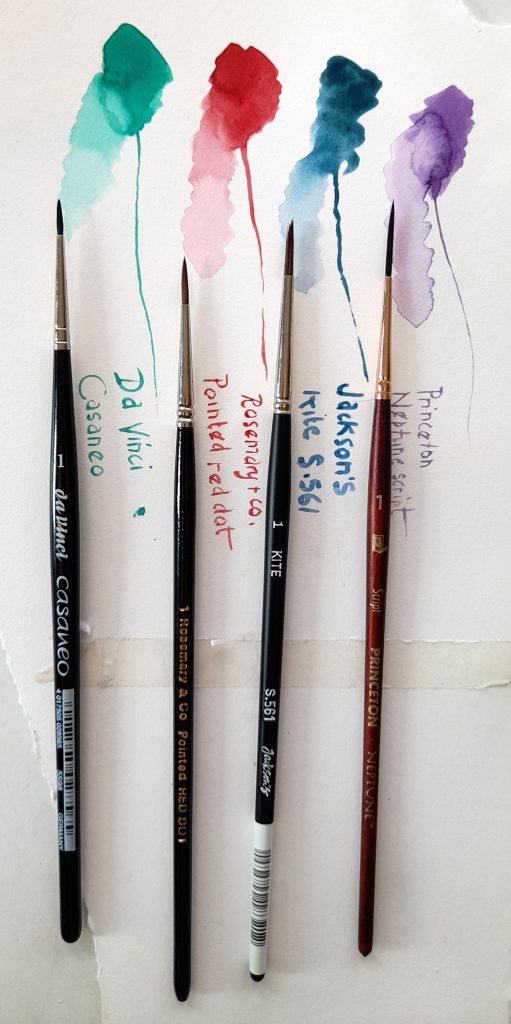
Here are the four brushes I’m reviewing. Left to right: Da Vinci Casaneo, Rosemary & Co Red dot Pointed, Jackson’s Kite S561 and Princeton’s Neptune Script. Links to all brushes in the text below.
The price I use for my Series 7 number 1 is a full discount price, not the full retail price of £17. 10 (2021 price). And these prices fluctuate a lot, with the brushes sometimes being as little as £5.80 each.
Princeton Neptune script
The first synthetic I’m trying is the Princeton Neptune script. This is a synthetic squirrel, rather than a synthetic sable.
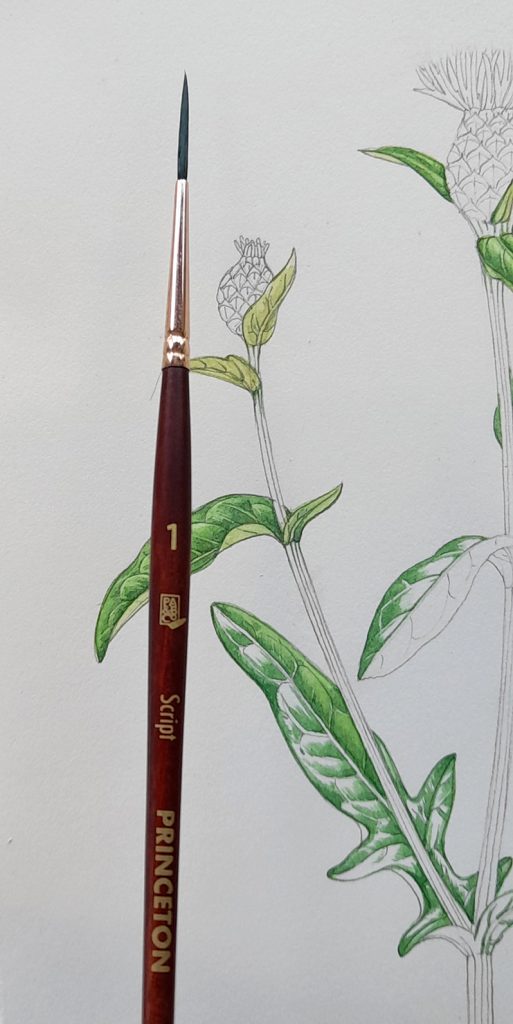
Princeton Neptune Script
First sight is alarming. It has an extremely long point, longer than any brush I’ve worked with before. Somewhere in the back of my mind the term “rigger” springs to mind. Is this the correct name for these long, fine-tipped brushes? After a little internet trawling it seems my hunch is right. Click here for more on rigger brushes, and how to use them.
However, despite my misgivings, on taking off the cover and using it I’m pleasantly surprised.
The tip is extremely fine, and doesn’t degrade or blunt at all for the whole time I use it. The synthetic squirrel holds a lot of paint, so you don’t need to keep refilling the brush. Thin lines build up next to one another without merging. Crisp edges are easy. Thin defining lines aren’t at all problematic. This brush is great!
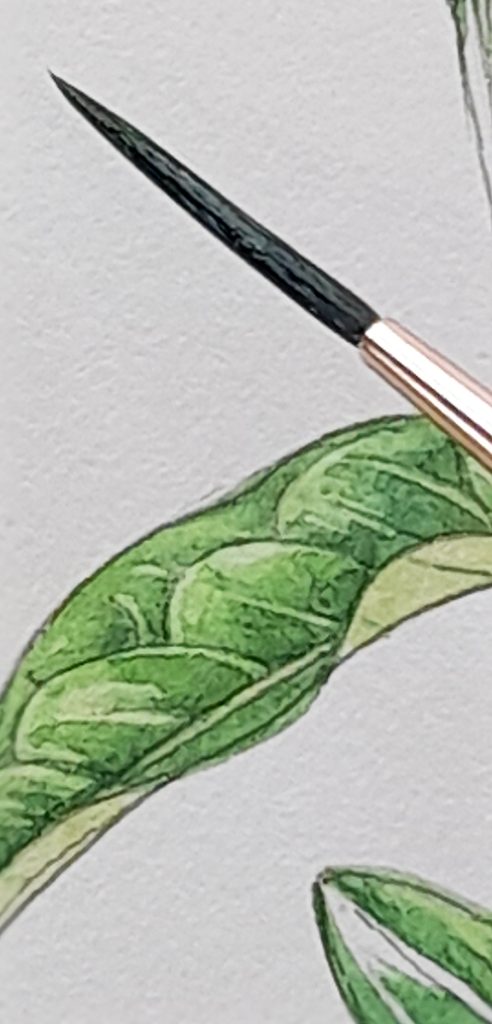
Princeton Neptune Script with leaf painted with the brush behind
My problem is the feel of such a long point. This is pronounced when I’m mixing colours. (Please don’t tell me to have a special rubbish-y brush for colour mixing. I know I should do, but when I’m working to dead-line I just don’t have time to keep switching brushes! Saying that, if you have a slightly more leisurely approach to your watercolour painting, it’s a great idea. Nothing trashes brushes faster than mixing colour with them).
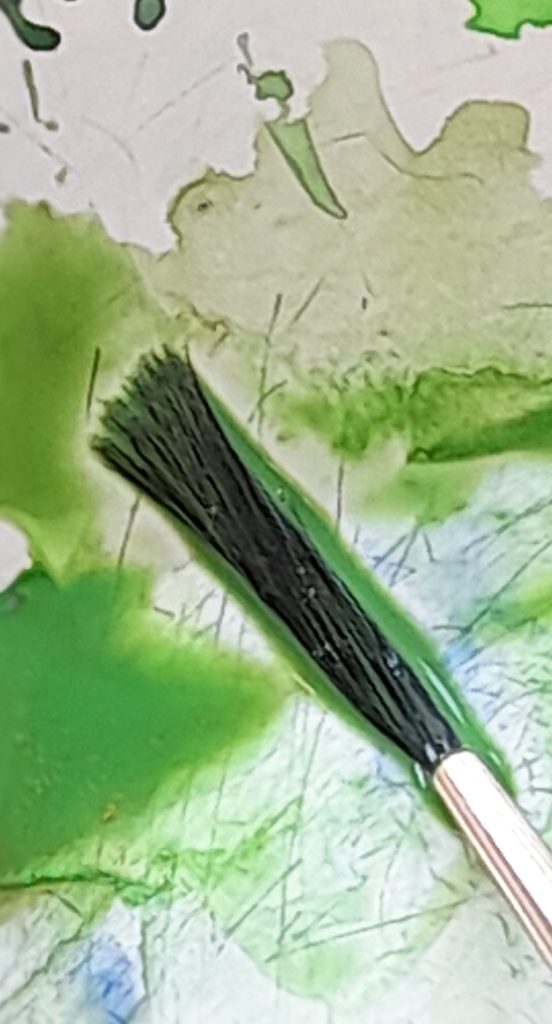
Mixing colour with the Princeton Neptune Script
The action of the brush on the page is lovely.
Because the tip is so very fine, perhaps it takes a little longer to build up areas of colour, and to my eye they look a little washed out when I’m done. Perhaps because each line is so very thin you do actually end up with less pigment on the page?
But for crisp detail, the Princeton Neptune Script is great.
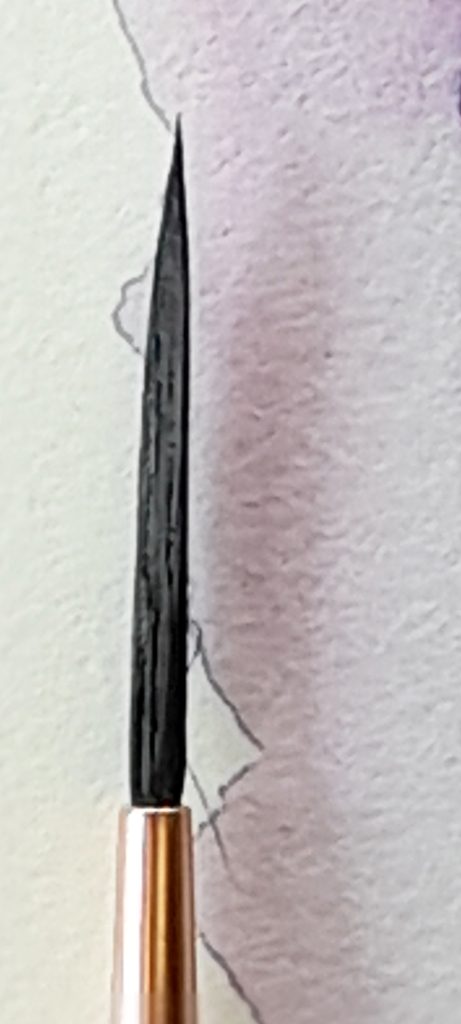
Close up of the tip of the Princeton Neptune Script brush
This brush retails at £4.90 – £6.10. My regular Series 7 no. 1 size brush retails (with a hefty discount) at £5.80, so this one is slightly cheaper.
Kite S561 by Jackson’s
This was the most expensive of the brushes I tested. It’s a synthetic sable and cost more than my Series 7 brush (£10.30), so I was expecting good things.
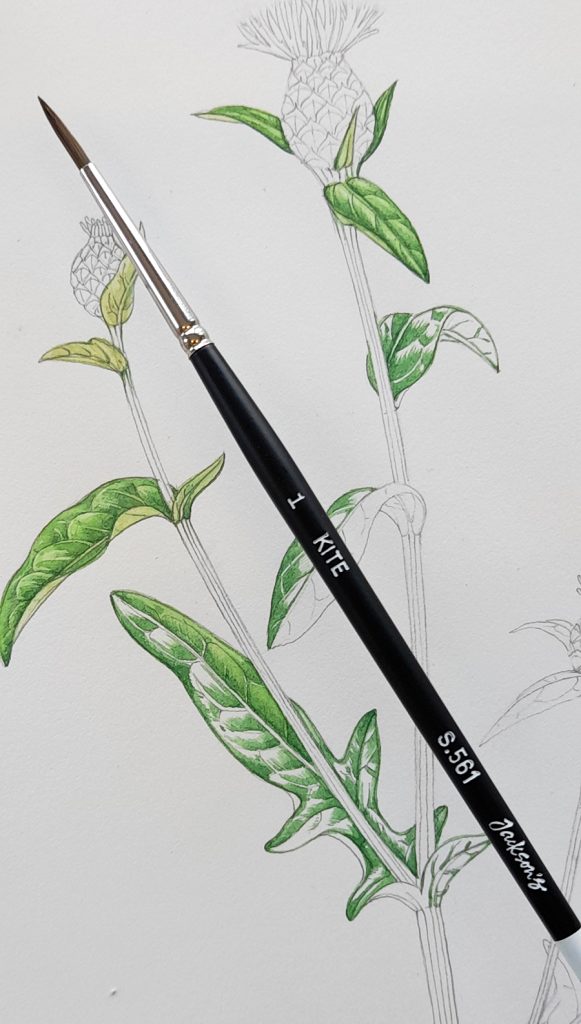
Jackson’s Kite S.561
Imagine my surprise when the Kite S561 simply didn’t work out that way. The tip of the brush is ragged, and blunt. It has a slight hook. In the hand, it feels the same shape and weight as a Series 7, but it’s not performing like one.
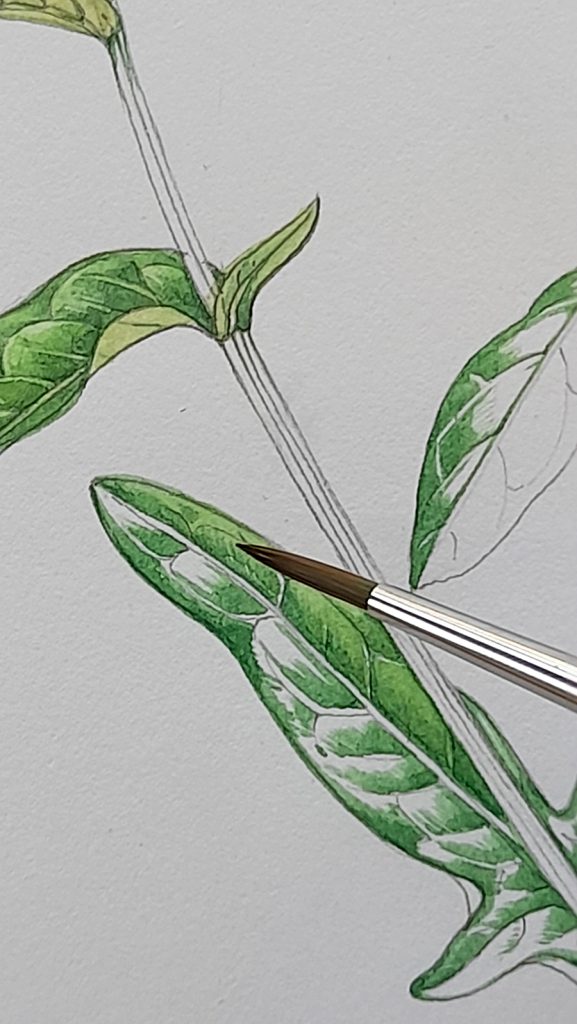
Jackson’s Kite S.561. Looks perfect but somehow…isn’t. The right had side of the leaf behind has been painted with this one.
The lines it leaves are thick and unpredictable. No matter how I twist the brush in the paint to “sharpen” it to a point, it remains blunt. In fact, I have to stop using it as it’s compromising the Knapweed illustration.
I’m disappointed. It could be a dud brush. But for the high price, I would have expected something far better, especially when the other synthetics on the market are priced so much more competitively.
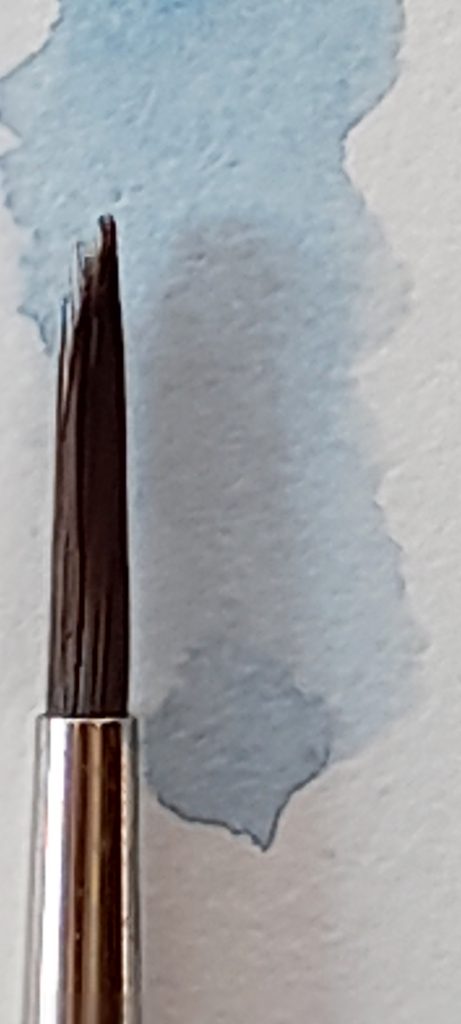
Close up of the tip of the Jackson’s Kite S.561 brush
Rosemary and Company Pointed Red Dot
I’m feeling optimistic with these Red Dot brushes, brought direct from the company (Rosemary and Company) Not only do they come recommended by the excellent botanical illustrator Polly O’Leary, but they’re the sister product to the Red Dot spotters that I reviewed and liked most in my last blog. They’re synthetic sable.
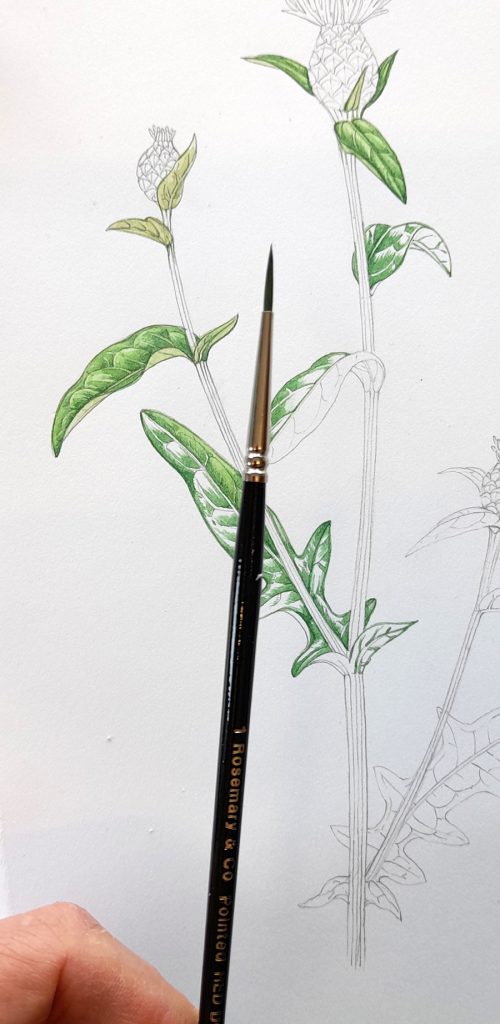
Rosemary & Co Red Dot Pointed brush
Initial feelings are fabulous. The brush looks and feels a lot like my Series 7. It has plenty of bulk to hold paint, and the point is tiny and crisp. This remains undamaged by mixing paint. Each brush-stroke delivers a little more than the Neptune script, so the colour builds up swifter and more saturated. So far so good.
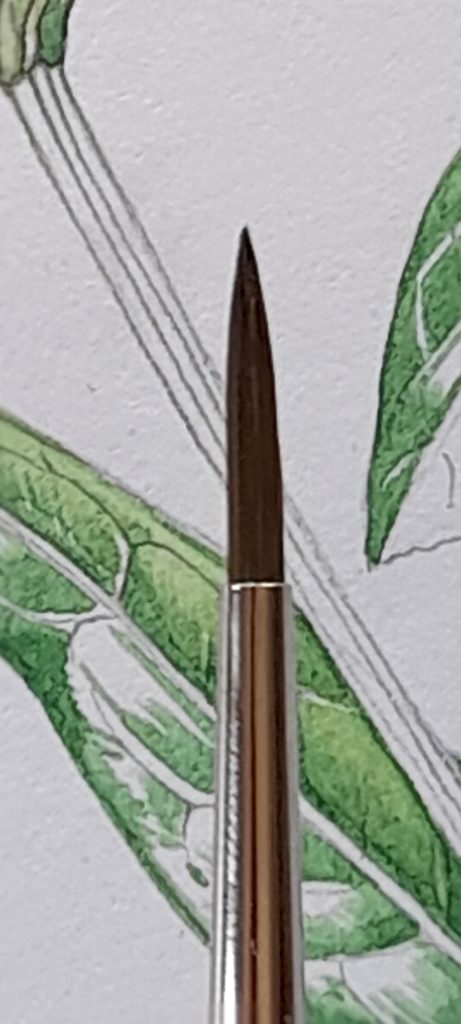
Close up of the Rosemary & Co Red dot Pointed with leaf painted with it behind
Then, after about 10 minutes, the brush starts to change. The tip loses its definition. I feel almost like the barrel of the brush swells, and seems to hang really low behind the tip, threatening to leave extra unwanted brush marks.
On the plus side, the “barrel” or well holds a lot of paint, so I don’t need to keep going back to my paint-box to top up on paint. The tip doesn’t become completely compromised, it’s still pretty sharp.
It’s not a disaster, but it’s certainly no longer nearly as good as when I first used it. And less enjoyable than the the Red Dot Spotter. But like I say, I know a lot of excellent botanical illustrators swear by these brushes. I don’t want to be too hasty in writing them off.
Price wise it only costs £2.75 though. So perhaps I was unlucky and had a “bad brush”. These things happen.
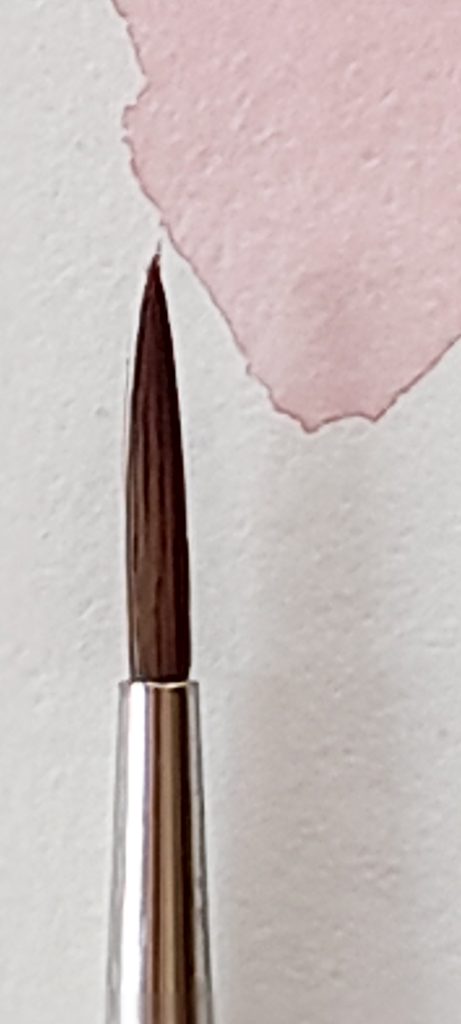
Close up of the tip of the Rosemary & Co Red Dot pointed brush
Da Vinci Casaneo 5598 Round
The Da Vinci is another synthetic squirrel, this time a Kazan squirrel. I had to look up “Kazan squirrel”. It seems to be a normal squirrel (although whether Red or Grey I couldn’t establish) from the Kazan region of Russia. So we continue. Anyway, it’s another synthetic.
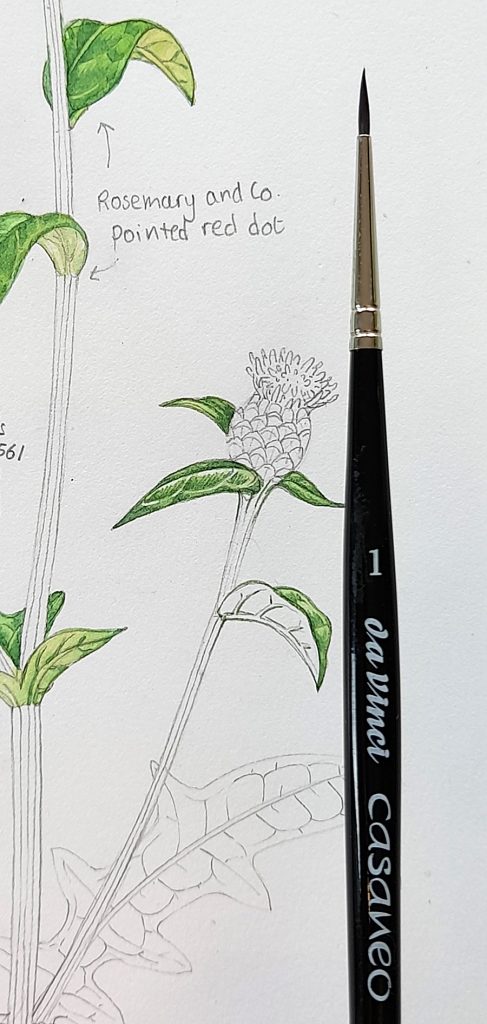
Da Vinci Casaneo brush with leaves painted with it behind and below
My initial response to this was not brilliant. The brush had a tiny hook at the tip. Not enough to make it un-useable, but not a good start.
I’d forgotten the useful tip I’ve been given about removing hooks from the tips of synthetic brushes:
It has come in from Rebecca, who left this suggestion in the comments section of my last watercolour brush blog . “Hooks that develop on synthetic bristles can often be remedied by dipping the bristles about half way into a cup of water taken off the boil. Take care not to get the ferrule or upper bristles wet with water this hot or it may affect the glue. The timing varies from 10-30 seconds based on the brand and size. Gently reshape the tip on your thumbnail after heating. While I don’t expect that is an annoyance one would want to deal with during a long painting session, it will at least restore the brush to a usable condition for lighter tasks.”
I started using the brush and it’s fine. The hook hasn’t thickened the line width, and the point remains tight.
After a few minutes though, it seems to develop some sort of lateral compression. The brush looks as if someone has squeezed it between thumb and finger. This leaves me feeling nervous. It feels like the brush could do something unexpected at any point, being this odd shape and with the little hook.
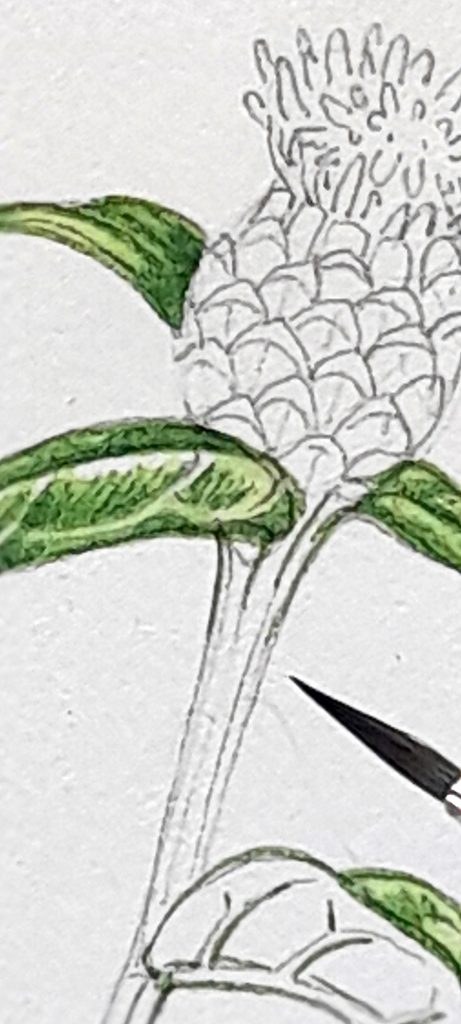
Nib of the Da Vinci Casaneo brush, showing the odd “compressed” effect
Although is paints perfectly well, the ominous feeling that it’s all about to go wrong doesn’t lift. I feel like I’m about to screw up the illustration at any point. I can’t relax into painting, but am hyper-vigilant, checking every stroke. This is no way to paint.
Because of this, even though the performance is better than all but the Princeton Neptune, I turn from the Da Vinci Casaneo.
Again, it could be a bad brush. Or just one that’s not perfect. Which, for someone who is as tough as a critic as I am, is basically the same thing.
It’s a shame. With a price point of £6.30, they’re not much more expensive than the price of my (discounted) Series 7 brushes. But are less reliable.
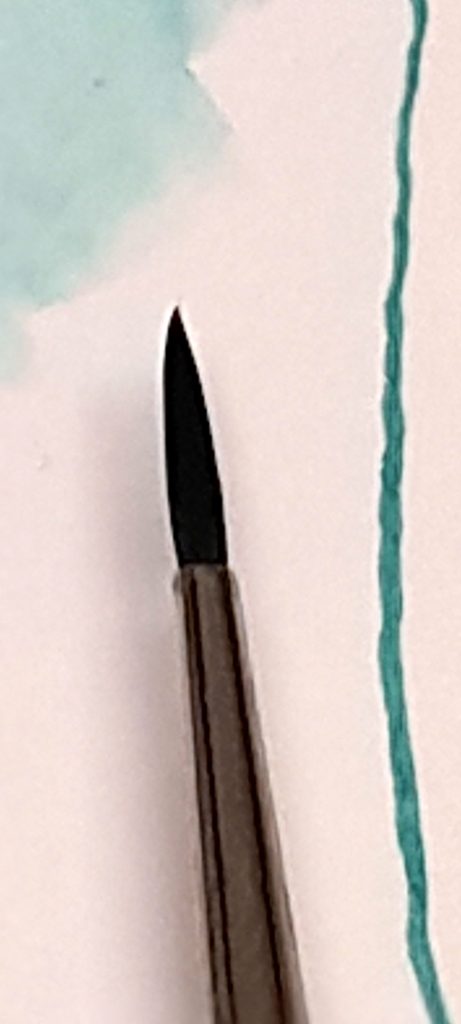
Close up of the nib of the Da Vinci Casaneo brush
Synthetics: Conclusion
Having tried all four brushes, I’m afraid none match my Series 7. Is this because it’s what I’m used to? Or because it’s a superior product? It’s hard to tell.
However, if I were to explore these synthetics further, I’d be focussing in on the Rosemary and Company Red dot range. I truly feel there will be a brush in there that suits me and my approach to painting. They’re cheap, and have lovely points. And although they seem to degrade quickly, I feel there’s scope for me to use them more before writing them off.
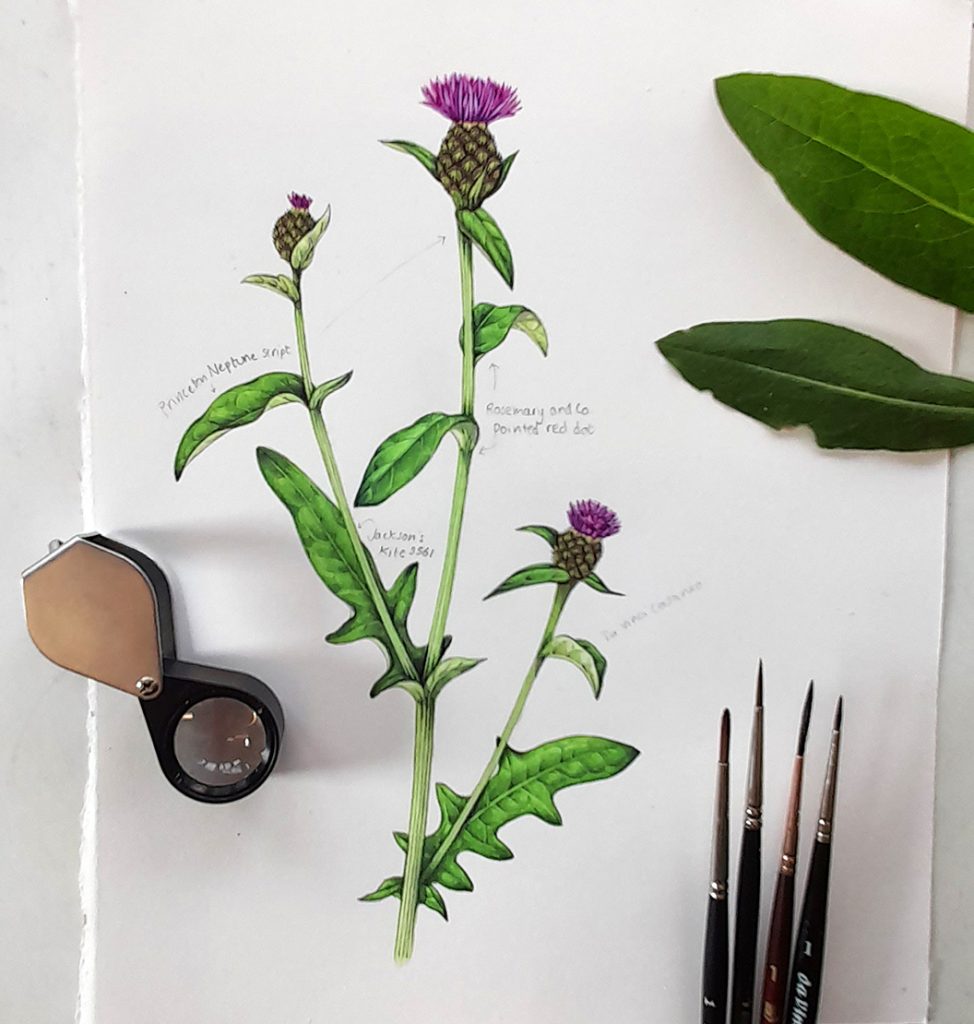
I did think the Princeton Neptune Script brush was brilliant, and held its point wonderfully. It’d be superb for doing tiny long hairs, say on the stem of a Wood rush Luzula sylvatica. But I just don’t think I can get used to wielding a brush that long. It feels too weird. I’m a creature of habit, and habit calls for a shorter, stouter brush. But they’re well worth a try if you’re less stuck in your ways than I am. In terms of getting detail and during the actual act of painting, the Neptune was my favourite out of these four brushes.
And here ends my exploration of synthetic brushes. There are many more brands out there, but I think I’m finished exploring. I’ll stick to a more detailed investigation of the Rosemary and Co brushes. I might play around with the Princeton Neptune and see if I can get used to such a long tip, and keep my fingers that I find the perfect solution soon. Only then will I be able to look at a weasel full in the face again.

Weasel Mustela nivalis (NOT the Siberian weasel, but a cousin)
For a lot more detail on this set of comparisons, please check out my Youtube video (or see it, below), and don’t forget to refer back to my other earlier review of synthetic brushes, both in blog form , and as a Youtube film.
Although I don’t plan on reviewing any more synthetics, please do put suggestions as to which you favour or have tried in the comments section below. I like the idea of these blogs and films being a good reference point for people on a similar journey, questing for the perfect synthetic brush.
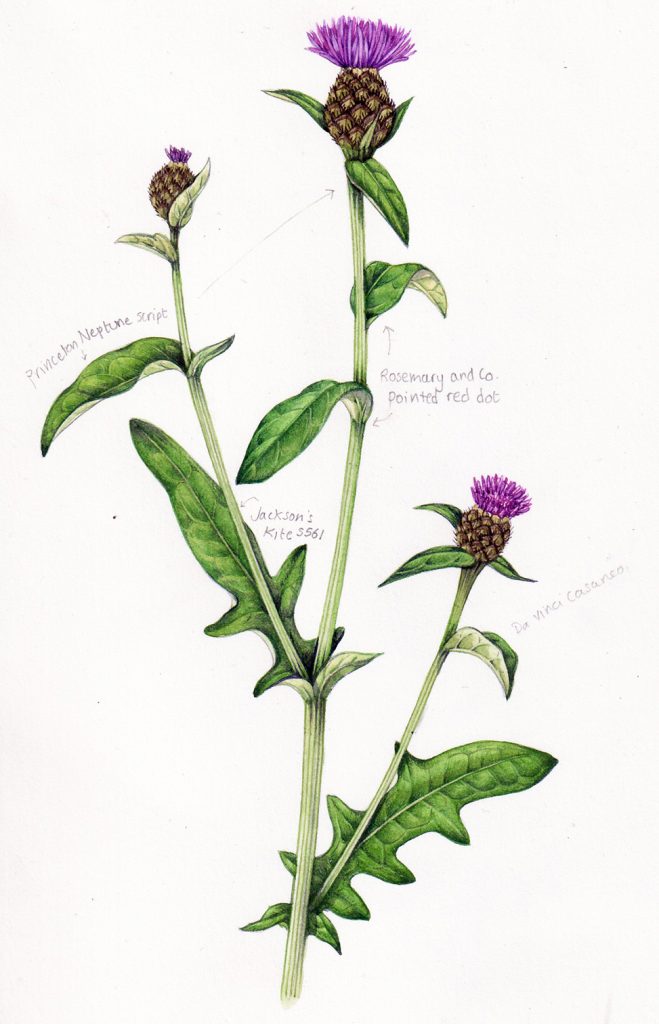
Annotated Illustration of Common or Black knapweed showing which leaves were done with which brush
The post Paintbrushes: Exploring synthetics Part 2 appeared first on Lizzie Harper.






